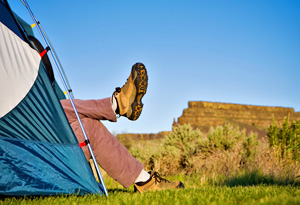Camping 101

Photo: Getty Images
Camping in a national park is an easy and affordable to way to make lasting memories. Ready to try it yourself? If you've never been camping, don't worry. Here are some tips to help you get started.
Involve Everyone: A camping trip is an opportunity for everyone to provide input. To get the kids excited about the upcoming adventure, let them help decide the destination, activities and menu. Have them practice setting up the tent before leaving home. Remind them to think of jokes or ghost stories to tell around the campfire. Once at the campground, assign them chores, like finding kindling for the fire or putting tent stakes into the ground.Choices, Choices: Most Americans live within a few hours drive of a national park. Use this interactive map to help you find one close to your home. If you are reluctant to pitch a tent your first night in the great outdoors, you can choose from other overnight options, including first-rate hotels, lodges, motels and cabins.
Going to the Drive-In: Pick a drive-in campground so that you can load your car with anything you think you might need, just in case. National parks have thousands of drive-in campsites. Some are first-come, first-serve; others can be reserved in advance through the park or through Recreation.gov.
Budget Friendly: The majority of national parks are free to enter. The most expensive entrance fee for any park is $25, and that price is good for everyone in the vehicle for an entire week. A campsite is generally less than $20 per night and comes with outstanding scenery.
Food for Thought: Good food is an important part of a great camping trip. Although it is possible to cook gourmet meals over a campfire, it's best to start simple. You can prepare food at home and reheat it at the campsite or purchase tasty premade, freeze-dried meals at any outdoor recreation store. The variety will amaze you. No campfire meal is complete without s'mores, so be sure to pack graham crackers, marshmallows and chocolate bars. As a backup, bring some no-cook options such as sandwiches, bread, jerky, cheese, fruit and canned goods. You can also fuel up at park snack bars or restaurants.
Supplies: It's important to think about and plan for what you need to bring. Make a checklist of items and be sure to include essentials such as a tent, sleeping bags and/or sleeping pads and blankets, ground cover (tarp or shower curtain), lanterns and flashlights, batteries, rope (a variety of uses), matches, a first aid kit, bug spray, sun block, soap, towels, shower shoes, warm clothes and waterproof clothes. If cooking, remember a camp stove, plates/pot/utensils (including tongs and long fork), oven mitt, food, water/water jug, dish towel, can opener, aluminum foil, hand sanitizer, dish soap, sponge and garbage bags.
Settle In: Once you have selected the destination, purchased the supplies and packed the car, it's time to hit the road. Be sure to arrive at your campsite early so you can unload, set up and explore your surroundings before dark. Most campgrounds have an official campground host who will be happy to answer any questions and help make your stay safe and enjoyable.
Leave No Trace: While enjoying the park, do whatever you can to minimize the impact you have on the environment. Stay on marked trails and follow park regulations. Observe wildlife from a distance and never approach, feed or follow an animal. Securely store your food and trash. Please don't disturb resources—as the saying goes, "take only pictures."
Enjoy: Take in all of the sights and sounds around you. Camping really does refresh both body and soul. Go on hikes, attend a campfire program, gaze at the stars, tell stories around the campfire and, most importantly, use the opportunity connect to nature and to each other.



